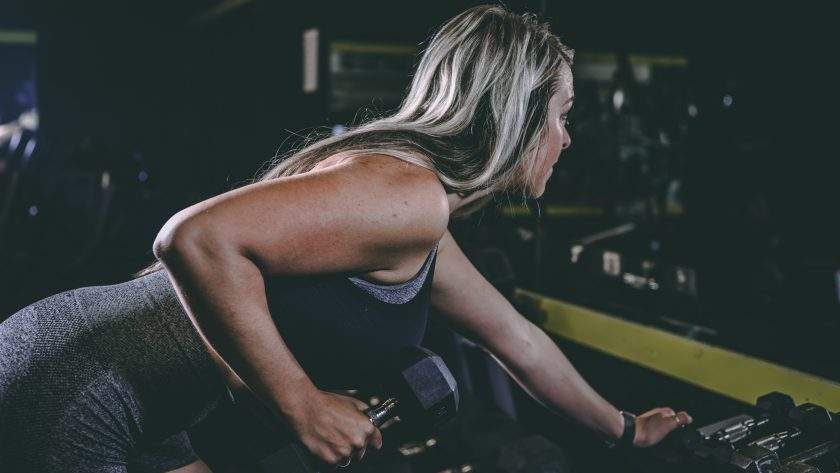Back pain is one of the most common problems that people deal with every day. Exercise often helps to ease back pain and prevent further discomfort. Back workouts are essential to strengthen the muscles that support the back and improve posture. Many people prefer to do their back workout at home due to convenience, and there are many exercises that can be done without equipment.
Understanding back anatomy is crucial when it comes to back workouts. The back is made up of several muscle groups, including the latissimus dorsi, rhomboids, and trapezius. Each muscle group plays a vital role in supporting the spine and maintaining good posture. Back workouts not only improve the appearance of the back but also help prevent back pain and injury.
Whether you are a beginner or an advanced athlete, there are many back workouts that can be done at home. Dumbbell rows, pull-ups, and push-ups are just a few examples of exercises that can be done without equipment. However, it is essential to perform each exercise with proper form and technique to avoid injury. In addition to back workouts, post-workout recovery, nutrition, and hydration are also crucial for optimal results.
Key Takeaways
- Back workouts are essential to strengthen the muscles that support the back and improve posture.
- Understanding back anatomy is crucial when it comes to back workouts.
- Whether you are a beginner or an advanced athlete, there are many back workouts that can be done at home.
Understanding Back Anatomy
Before diving into your back workout at home, it’s important to understand the anatomy of the back muscles. The back consists of several muscles, including the erector spinae, lats, traps, teres major, rhomboids, and multifidus. Each muscle has a specific function and plays a crucial role in maintaining spinal stability and posture.
The erector spinae muscles, for example, run along the spine and help to extend and rotate the back. The lats, or latissimus dorsi, are the largest muscles in the back and are responsible for pulling the arms down and back. The traps, or trapezius, cover the middle of the back and are divided into three distinct subsets: the upper trap, middle trap, and lower trap. The teres major and rhomboid muscles also contribute to shoulder blade movement and stability.
Having a strong back is essential for maintaining good posture and preventing pain and injuries. The back muscles are part of the posterior chain, which also includes the glutes, hamstrings, and calves. Strengthening the posterior chain can improve athletic performance and reduce the risk of lower back pain.
In addition to the back muscles, the rotator cuff and deltoids also play a role in back exercises. The rotator cuff muscles help to stabilize the shoulder joint, while the deltoids assist in shoulder abduction and flexion. Exercises that target these muscles can improve overall shoulder health and mobility.
Understanding the anatomy of the back muscles is crucial for selecting the right exercises and ensuring proper form. By targeting each muscle group with specific exercises, you can achieve a well-rounded and effective back workout at home.
Importance of a Back Workout at Home
Back workouts are an essential part of any fitness journey, and they play a vital role in strengthening the core muscles of the body. A strong back not only improves posture but also helps in preventing back pain and injury. Incorporating back workouts into your daily routine can help you achieve a strong and healthy back.
During a back workout, the focus is on strengthening the muscles of the back, shoulders, and chest. These muscles work together to support the spine and maintain good posture. A strong back also helps in improving form during other exercises like deadlifts, squats, and bench press.
Your back workout at home can be done with or without equipment. Strengthening exercises like pull-ups, rows, and bridges can be done using resistance bands, dumbbells, or bodyweight. These exercises not only strengthen the back muscles but also improve overall body strength.
Form is crucial when performing back exercises, and it is essential to maintain proper form to prevent injury. Starting with low weights and gradually increasing the intensity can help in building strength and avoiding injury.
Incorporating back workouts into your fitness routine can help you achieve a strong and healthy back. Strong back muscles not only improve posture but also aid in preventing back pain and injury. With the right form and intensity, back workouts can be done at home with or without equipment, making it a convenient and effective way to improve overall fitness.
Back Pain and Injury Prevention During Your Back Workout at Home
Back pain and injury are common issues that can arise from exercising incorrectly or not taking proper precautions. However, there are ways to prevent these issues and ensure a safe and effective workout. Here are some tips to keep in mind:
- Start slowly and gradually increase intensity: If you’re new to working out or returning from an injury, it’s essential to start slowly and gradually increase the intensity of your workouts. This will help prevent injury and avoid exacerbating any existing pain.
- Use proper form: Using proper form is crucial when performing any exercise, especially those that target the back muscles. Improper form can put unnecessary strain on your back and lead to pain or injury. Make sure to follow proper form guidelines and seek guidance from a professional if necessary.
- Listen to your body: It’s essential to listen to your body and pay attention to any pain or discomfort you may be experiencing. If you feel pain during an exercise, stop immediately and seek guidance from a professional.
- Incorporate stretching and mobility exercises: Incorporating stretching and mobility exercises into your routine can help prevent back pain and injury. These exercises can help improve flexibility and range of motion, reducing the risk of injury during exercise.
- Follow medical guidelines: If you have a history of back pain or injury, it’s essential to follow medical guidelines and consult with a professional before beginning any exercise program. They can provide guidance on exercises that are safe for you and help prevent further injury.
By following these tips, you can help prevent back pain and injury and ensure a safe and effective workout. Remember to always listen to your body and seek guidance from a professional if necessary.
Back Workout at Home Without Weights
For those who prefer to work out at home without weights, there are plenty of effective back exercises that can be done using just your bodyweight. These exercises not only target your back muscles but also improve your overall fitness level. Here are some of the best back workouts without weights that you can try at home:
Superman Exercise
This exercise targets the lower back muscles and improves core stability. To perform this exercise, lie on your stomach with your arms extended out in front of you and your legs straight back behind you. Lift your arms, legs, and chest off the ground simultaneously, hold for a few seconds, and then lower back down.
Plank with Shoulder Taps
This exercise targets your back muscles, obliques, and core muscles. Start in a plank position with your hands directly under your shoulders and your body in a straight line. Tap your left shoulder with your right hand, return to the starting position, and then tap your right shoulder with your left hand. Continue alternating sides.
Reverse Snow Angels
This exercise targets your upper back muscles and improves mobility. Lie face down with your arms extended out to the sides and your palms facing down. Lift your arms off the ground, keeping them straight, and bring them together above your head. Lower back down to the starting position and repeat.
Bridge
This exercise targets your glutes, hamstrings, and lower back muscles. Lie on your back with your knees bent and your feet flat on the ground. Lift your hips off the ground, keeping your shoulders and feet on the ground. Hold for a few seconds and then lower back down.
Bird Dog
This exercise targets your lower back muscles and improves core stability. Start on your hands and knees with your hands directly under your shoulders and your knees directly under your hips. Lift your left arm and right leg off the ground simultaneously, hold for a few seconds, and then lower back down. Repeat on the opposite side.
Incorporating these back workouts without weights into your at-home fitness routine can help improve your overall fitness level and strengthen your back muscles.
Back Workout at Home With Dumbbells
Dumbbells are a great piece of equipment to use for back workouts at home. They are versatile and can be used for a variety of exercises that target different areas of the back muscles. Here are some effective dumbbell back exercises to help build strength and muscle:
Dumbbell Row
The dumbbell row is a classic exercise that targets both the lats and rhomboids. To perform this exercise, stand with your feet shoulder-width apart and hold a dumbbell in each hand with your palms facing your body. Bend your knees slightly and hinge forward at the hips. Keep your back straight and pull the dumbbells up towards your chest, squeezing your shoulder blades together. Lower the dumbbells back down and repeat for several reps.
Hammer Curl
The hammer curl is a great exercise that targets the forearms and grip strength, which can help with other back exercises. To perform this exercise, hold a dumbbell in each hand with your palms facing your body. Keep your elbows close to your sides and curl the dumbbells up towards your shoulders. Lower the dumbbells back down and repeat for several reps.
One-Arm Dumbbell Row
The one-arm dumbbell row is a variation of the dumbbell row that targets one side of the back at a time. To perform this exercise, place one knee and hand on a bench or sturdy surface and hold a dumbbell in your other hand with your palm facing your body. Keep your back straight and pull the dumbbell up towards your chest, squeezing your shoulder blade. Lower the dumbbell back down and repeat for several reps before switching sides.
Using dumbbells for back workouts at home can be a great way to build strength and muscle. Incorporating exercises like the dumbbell row, hammer curl, and one-arm dumbbell row can help target different areas of the back muscles and improve grip strength and forearm development.
Advanced Back Workout at Home
For those looking to take their back workouts to the next level, there are a variety of advanced exercises and techniques to try at home. Incorporating variations of exercises such as pull-ups, rows, and deadlifts can help target different areas of the back and prevent plateauing.
One effective technique to try is high-intensity interval training (HIIT) for back workouts. This involves performing exercises at a high intensity for a short period of time, followed by a brief rest period. This can help increase the heart rate and burn more calories while also challenging the muscles in the back.
Another advanced technique is incorporating deadlifts and good mornings into the workout routine. These exercises can help target the lower back and hamstrings, while also strengthening the core. It is important to use proper form and start with lighter weights before gradually increasing the weight to avoid injury.
In addition to incorporating new exercises and techniques, it is also important to vary the rep and set ranges to prevent adaptation and continue to challenge the muscles. This can include performing higher reps with lighter weights or lower reps with heavier weights.
Overall, incorporating advanced techniques and exercises into a back workout routine can help target different areas of the back and prevent plateauing. It is important to use proper form and gradually increase weight and intensity to avoid injury.
Post-Workout Recovery After Your Back Workout at Home
After a good back workout at home, it’s essential to allow your muscles to recover properly. Not giving your muscles enough time to heal can lead to pain and strain, which can affect your performance in future workouts. Here are some tips for post-workout recovery that can help you avoid injuries and improve your results.
Firstly, it’s important to stretch your muscles after a workout. Stretching can help reduce muscle soreness and stiffness. Focus on stretching your glutes and hamstrings, as these muscles are often engaged during back exercises. Hold each stretch for 30 seconds to a minute, and repeat each stretch two to three times.
Secondly, consider using resistance bands to aid in your post-workout recovery. Resistance bands can help improve flexibility and reduce muscle soreness. You can use them for exercises such as pull-aparts and rows, which can help stretch and strengthen your back muscles.
Thirdly, don’t forget to hydrate after a workout. Drinking water can help reduce muscle soreness and prevent cramps. Aim to drink at least 16 ounces of water within 30 minutes of finishing your workout.
Lastly, consider doing some light exercise on your recovery days, such as walking or yoga. Engaging in active recovery can help improve blood flow to your muscles, which can promote healing and reduce soreness.
Overall, taking care of your body after a back workout at home is just as important as the workout itself. By following these post-workout recovery tips and allowing your muscles to heal properly, you can improve your performance and avoid injuries in future workouts.
Nutrition and Hydration For Your Back Workout at Home
Proper nutrition and hydration are crucial for anyone looking to get the most out of their back workout at home. It is important to fuel your body with the right nutrients to maximize your performance and achieve your fitness goals.
For the average person, it is recommended to consume around 2,000 to 2,500 calories per day. However, this number may vary depending on the individual’s age, gender, weight, and activity level. For those who are looking to build muscle and increase their back strength, it is recommended to consume an additional 300 to 500 calories per day.
In addition to consuming the right number of calories, it is important to focus on consuming the right types of foods. Eating a balanced diet that includes plenty of protein, complex carbohydrates, and healthy fats can help provide the energy and nutrients needed for an effective back workout.
Hydration is also key for optimal performance during a workout. It is recommended to drink at least 8 to 10 glasses of water per day, and even more on days when you are exercising. Dehydration can lead to fatigue, cramps, and decreased performance, so it is important to stay hydrated throughout the day.
Some tips for staying hydrated include carrying a water bottle with you throughout the day, drinking water before, during, and after your workout, and consuming foods that are high in water content, such as fruits and vegetables.
By focusing on proper nutrition and hydration, you can fuel your body for an effective back workout at home and achieve your fitness goals.
Frequently Asked Questions
What are some effective back exercises that can be done at home?
There are several effective back exercises that can be done at home without any equipment. Some of these exercises include bodyweight rows, pull-ups, and push-ups. These exercises focus on the upper back and help to strengthen and tone the muscles.
What is the best way to train your back muscles without equipment?
The best way to train your back muscles without equipment is to use bodyweight exercises. These exercises use your own body weight as resistance and can be done anywhere. Bodyweight exercises like pull-ups, push-ups, and bodyweight rows are great for strengthening and toning the back muscles.
How can you build back muscles at home without weights?
There are several ways to build back muscles at home without weights. Bodyweight exercises like pull-ups, push-ups, and bodyweight rows are great for building back muscles. You can also use household items like water jugs or backpacks filled with books as weights to add resistance to your exercises.
What are some back workouts that can be done with dumbbells and barbells at home?
If you have access to dumbbells and barbells at home, there are several back workouts you can do. Some of these workouts include dumbbell rows, dumbbell pullovers, and barbell deadlifts. These exercises are great for building strength and muscle in the back.
What are some full back workout routines that can be done at home?
A full back workout routine can be done at home using a combination of bodyweight exercises and dumbbell/barbell exercises. A sample routine could include pull-ups, dumbbell rows, barbell deadlifts, and bodyweight rows. This routine targets all areas of the back and helps to strengthen and tone the muscles.
What are the top 5 back exercises that can be done without equipment?
The top 5 back exercises that can be done without equipment are pull-ups, push-ups, bodyweight rows, reverse snow angels, and supermans. These exercises target all areas of the back and help to strengthen and tone the muscles. Incorporating these exercises into your workout routine can help you achieve a strong and healthy back.
Other Posts You May Enjoy!
- “Get Your Back into Shape: The Ultimate Back Exercises Guide for Building a Stronger, Defined Back”

- “Say Goodbye to Lower Back Pain: The Ultimate Path To a Healthy Spine”

- “Master the Pendlay Row: The Ultimate Guide to Building a Stronger Back and Bigger Muscles”

- “Fly Like a Superhero: The Ultimate Guide on Why the Reverse Fly Should Be in Your Workout Routine”

- “Chest Support Row: The Ultimate Exercise for Building a Strong Back and Bulletproof Shoulders”

EXPAND YOUR MIND
Join the best newsletter that you never knew you needed. You’ll get emails containing grooming tips, new blog posts, product launches, giveaways, and motivation to help you Keep on Keeping on.


